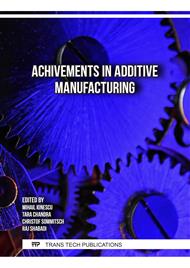p.13
p.19
p.27
p.33
p.41
p.47
p.53
p.59
p.65
Production of a Ti6Al4V Automobile’s Lower Control Arm with EBM
Abstract:
Lattice structures and Topology Optimization are two of the main routes to design lightweight high resistance components. These design techniques often lead to complex geometries not obtainable by traditional manufacturing. In this work we show how Additive Manufacturing (AM) of metals can be a successful way to reach that result. At first, we studied Ti6Al4V samples produced by Electron Beam Melting (EBM) to determine the mechanical properties of the base material. Hot Isostatic Pressing (HIP) was performed on a part of these samples to understand the impact of this process on defects and material properties. The results we obtained showed that the properties of Ti6Al4V produced by EBM are comparable to the one of the conventionally produced one. Given these results we redesigned an automobile’s lower control arm to reduce its mass: considering both Topology Optimization (TO) and lattice structures. Ti6Al4V components with different lattice structures were successfully manufactured by EBM.
Info:
Periodical:
Pages:
41-46
Citation:
Online since:
November 2023
Keywords:
Price:
Сopyright:
© 2023 Trans Tech Publications Ltd. All Rights Reserved
Share:
Citation:



